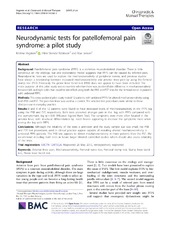| dc.contributor.author | Vegstein, Kristine | en_US |
| dc.contributor.author | Robinson, Hilde Stendal | en_US |
| dc.contributor.author | Jensen, Roar | en_US |
| dc.date.accessioned | 2020-06-17T07:53:25Z | |
| dc.date.available | 2020-06-17T07:53:25Z | |
| dc.date.issued | 2019-05-08 | |
| dc.Published | Vegstein K, Robinson HS, Jensen R. Neurodynamic tests for patellofemoral pain syndrome: A pilot study. Chiropractic and Manual Therapies. 2019;27:26 | eng |
| dc.identifier.issn | 2045-709X | |
| dc.identifier.uri | https://hdl.handle.net/1956/22666 | |
| dc.description.abstract | Background Patellofemoral pain syndrome (PFPS) is a common musculoskeletal disorder. There is little consensus on the etiology, but one explanatory model suggests that PFPS can be caused by referred pain. Neurodynamic tests are used to explore the mechanosensitivity of peripheral nerves, and previous studies have shown a relationship between increased mechanosensitivity and anterior knee pain by using the femoral slump test (FST). Previously the prone knee bend test (PKB) does not appear to have been included. The main purpose of this pilot study was to examine whether there was an identifiable difference in mechanosensitivity between left and right sides that could be identified using both the PKB and FST tests for the femoral nerve in patients with unilateral PFPS. Methods This cross-sectional pilot study tested 12 patients with unilateral PFPS for altered mechanosensitivity using both PKB and FST. The pain-free knee was used as a control. The selected test procedures were similar to those clinicians use in everyday practice. Results 8 and 4 of the 12 patients were found to have increased levels of mechanosensitivity in the PFPS leg using the PKB and FST, respectively. Both tests provoked stronger pain in the leg with PFPS compared with the asymptomatic leg (p < 0.05 Wilcoxon Signed Rank Test). The symptoms were more often located in the anterior knee, with structural differentiation by neck flexion appearing to increase the symptoms more when testing the leg with PFPS. Conclusions Although the reliability of the tests is unknown and the study sample size was small, the PKB and FST test procedures used in clinical practice appear capable of revealing altered mechanosensitivity in unilateral PFPS patients. The PKB test appears to detect mechanosensitivity in more patients than the FST. We recommend including both tests in future larger blinded controlled studies which should also assess reliability of the tests. Trial registration ISRCTN 12473526. Registered 20 May 2015, retrospectively registered. | en_US |
| dc.language.iso | eng | eng |
| dc.publisher | BMC | eng |
| dc.rights | Attribution CC BY | eng |
| dc.rights.uri | http://creativecommons.org/licenses/by/4.0/ | eng |
| dc.title | Neurodynamic tests for patellofemoral pain syndrome: A pilot study | en_US |
| dc.type | Peer reviewed | |
| dc.type | Journal article | |
| dc.date.updated | 2020-01-29T12:59:45Z | |
| dc.description.version | publishedVersion | en_US |
| dc.rights.holder | Copyright 2019 The Author(s) | |
| dc.identifier.doi | https://doi.org/10.1186/s12998-019-0242-2 | |
| dc.identifier.cristin | 1707458 | |
| dc.source.journal | Chiropractic and Manual Therapies | |

